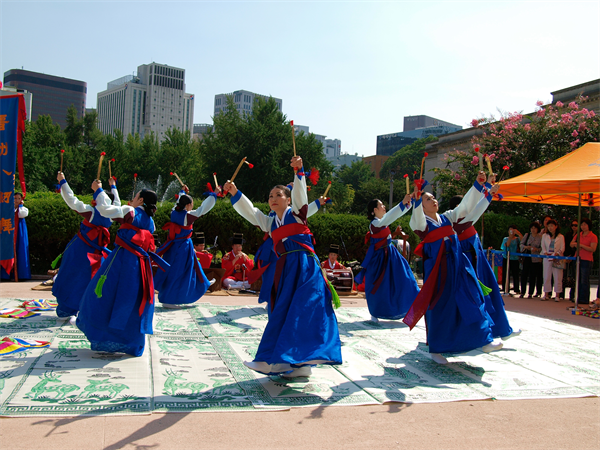- CURRENT LOCATION: HOME
- >> About Shaanxi
- >> Global Associations
- >> Sister Cities
- >>
- Xi'an
Jinju (South Korea)
2017-04-17 13:44:25 , Source : The Government Website of Shaanxi Province
Jinju is a city in South Gyeongsang Province, South Korea. It was the location of the first (1592) and second (1593) Sieges of Jinju by Japanese forces during the Imjin War. The Republic of Korea Air Force Education and Training Command is located in the eastern part of the city. There are cultural-historical tourist attractions in Jinju such as Jinju Castle (ko), the Jinju National Museum, and the Nam-gang Prehistoric Site Museum.
History
From old times, Jinju was a fountainhead of national culture and spirit. As a city that has held 1,000-year-old historical heritage of the ancient city, Jinju has been well renowned as a home of patriotic spirit, education, culture and art.
Jinju was an ancient city of Goryeonggaya in the Gaya Era. This city was called 'Geoyeolseong' of Baekje during the Three Kingdom Era, and was called 'Geoyeolju', 'Cheongju', and 'Gangju' during the Unified Silla Era. Name of this city was changed into 'Jinju' for the first time in the 23rd year of King Taejong of the Goryeo Dynasty (940).
It became 'Jinju-mok', one of 12 moks (local administrative units in Goryeo and Joseon Dynasty) in the 2nd year of King Seongjong (983). In the 33rd year of King Gojong of the Joseon Dynasty (1896), administrative district of the nation was reorganized with 13 provinces. At that time Jinju began to belong to Gyeongsangnam-do, and became capital town of Gyeongsangnam-do. And provincial governor started to reside in Jinju. On April 1, 1925, Busan replaced Jinju as provincial capital.
On August 15, 1949, the government of the Republic of Korea was established and 'the local self-government system' was started. At that time, Jinju-bu was raised to Jinju-si (city) and started to have mayor of the city. On January 1, 1995, in accordance with 'the Law pertaining to the establishment of Urban-Rural Integrated City', Jinju-si and Jinyang-gun became extinct and were merged into one integrated Jinju-si (city).
Culture and festivals
There are cultural events held in Jinju every year. Among these is the Jinju Namgang Lantern Festival which is held in October for approximately ten days. This nationally designated cultural tourism festival, found only in Jinju, features a spectacle of lanterns floating on the Nam River to commemorate the patriotic spirit of the 70,000 militia corps and government troops who died for their country defending Jinju from the Japanese forces during the Imjin War (1592–1598). Other major festivals include: the Nongae Festival, the Korea Drama Festival, the Gaecheon Arts Festival and the Jinju National Bullfighting Contest.
The Nongae Festival, held in May each year commemorates and celebrates the sacrifice of the beautiful and patriotic gisaeng (professional Korean entertainer) Nongae's suicide-assassination of a Japanese general together with the 70,000 Koreans who lost their lives in the battle of Jinju Castle during the Imjin War. The festival features an emotional reenactment of Nongae's suicidal drowning of a Japanese general from uiam bawi (righteous rock) below Chokseongnu (Jinju castle pavilion) on the banks of the Nam River.
Gaecheon Arts Festival is annually held from October 3 to 10 and the entire city turns to the streets for celebration at Korea's first provincial culture art festival, which awakens the artistic spirit of the Korean people. The festival falls around Gaecheonjeol (National Foundation Day) and is widely regarded as one of Korea's finest.
The Jinju National Bullfighting Contest is recognized as Korea's oldest bullfighting event and spectators can witness a test of strength at this bullfighting contest held at a purpose-built traditional Korean sports arena near Jinyang lake.
Jinju cuisine
Jinju has a number of distinctive local delicacies which reflect the tastes of Jinju people. Perhaps most celebrated is Jinju bibimbap, which distinguishes itself from the common Korean rice and vegetable dish by its use of yukhoe, made with raw beef and generous amounts of sesame oil. Also famous is Namgang (Nam River) Grilled Eel (minmul jangeo), which is caught locally and served in any one of the numerous restaurants overlooking the Nam. Enjoying their food spicy, Jinjuites have also perfected a hot pepper (ttaengcho) version of the popular Korean side dish pajeon (scallion pancake) known by its colloquial name jijimi. This is best enjoyed with a bowl of local rice wine makkeolli.
Silk industry
Since ancient days, silk processed in Jinju has been known for its superior quality, which is a result of the combination of natural resources (such as clean water of Mt. Jirisan and so on) and human resources. Silk factories in Jinju annually spin out 70% of the national production. Jinju silk has a soft, refined feeling and elegant colors because of its superior dyeing techniques.
Education
Jinju is an educational city and is home to Gyeongsang National University and Chinju National University of Education, Gyeongnam National University of Science and Technology. It is also home to International University of Korea, catering mostly to foreign students. It also has a number of community colleges that serve the local area. Jinju's high schools also offer a high quality of education and have a wide catchment area, reaching beyond the city limits to attract students from surrounding towns such as: Sacheon, Hadong and Sancheong.
Economy and business
Jinju was named as one of several 'enterprise cities' by the South Korean government. The government has supported Jinju as a hub of bio-industrial technological innovation from Dec. 1, 2000. The government provided 5 billion won from 2000 to 2004 in biological and chemical material industries in Jinju. There are 618 manufacturing companies (the number of employees: 11,806), 1 local industrial complex and 4 rural industrial complexes as part of an integrated urban and rural city.

Government Organizations



Other Links

Copyright@www.shaanxi.gov.cn All Rights Reserved
Registration Number:陕ICP备10004160号
